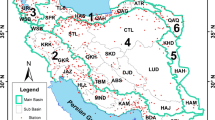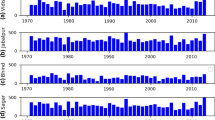Abstract
Water resources management is a complex task and is further compounded by droughts. This study applies a multilayer perceptron network optimized using Levenberg–Marquardt (MLP) training algorithm with a tangent sigmoid activation function to forecast quantitative values of standardized precipitation index (SPI) of drought at five synoptic stations in Iran. The study stations are located in different climatic regions based on De Martonne aridity index. In this study, running series of total precipitation corresponding to 3, 6, 9, 12, and 24 months were used and the corresponding SPIs were calculated: SPI3, SPI6, SPI9, SPI12, and SPI24. The multilayer perceptrons (MLPs) for SPIs with the 1-month lead time forecasting, were tested and validated. Four different input vectors were considered during network development. In the first model, MLP constructed by importing antecedent SPI with 1-, 2-, 3-, and 4-month time lags and antecedent precipitation with 1- and 2-month time lags (MLP1). Addition of antecedent North Atlantic Oscillation or antecedent Southern Oscillation Index with 1-month time lag or both of them to MLP1 led to MLP2, MLP3, and MLP4, respectively. The MLP models were evaluated using the root mean square error (RMSE) and the coefficient of determination (R 2). The results showed that MLP4 had a higher prediction efficiency than the other MLPs. The more satisfactory results of RMSE and R 2 values of MLP4 for 1-month lead time for validation phase were equal to 0.35 and 0.92, respectively. Also, results indicated that MLPs can forecast SPI24 and SPI12 more accurately than the other SPIs.



Similar content being viewed by others
References
Abolverdi J, Khalili D (2010) Probability analysis of extreme regional meteorological droughts by L-moments in a semi-arid environment. Theor Appl Climatol 102:351–366
Cullen HM, Kaplan A, Arkin PA, Demenocal PB (2002) Impact of the North Atlantic oscillation on Middle Eastern climate and streamflow. Clim Change 55:315–338
Dawson CW, Wilby R (1998) An artificial neural network approach to rainfall runoff modeling. Hydrol Sci J 43:47–66
De Martonne E (1942) Nouvelle carte mondiale de l'indice d'aridité. Ann Géogr 51:242–250
Dracup JA, Lee KS, Paulson EN Jr (1980) On the statistical characteristics of drought events. Water Resour Res 16(2):289–296
Edossa DC, Babel MS, Gupta AD (2010) Drought analysis in the Awash river basin, Ethiopia. Water Resour Manage 24:1440–1460
Edwards CD, McKee TB (1997) Characteristics of 20th century drought in the United States at multiple time scales. Atmospheric Science Paper No. 634, Climatology Report, No. 97–2, Dep Atmos Sci, Colorado State Univ
Goyal MK, Ojha CSP (2011) PLS regression-based pan evaporation and minimum–maximum temperature projections for an arid lake basin in India. Theor Appl Climatol 105(3–4):403–415
Hayes MJ, Svoboda MD, Wihite DA, Vanyarhko OV (1999) Monitoring the 1996 drought using the standardized precipitation index. Bull Am Meteorol Soc 80(3):429–438
Hosseinzadeh Talaee P, Heydari M, Fathi P, Marofi S, Tabari H (2011) Numerical model and computational intelligence approaches for estimating flow through rockfill dam. J Hydrol Eng ASCE. doi:10.1061/(ASCE)HE.1943-5584.0000446
Hurrell JW (1995) Decadal trends in the North Atlantic Oscillation: regional temperatures and precipitation. Science 269:676–679
Jamshidi H, Rezaeian Zadeh M, Abghari H, Khalili D, Singh VP (2009) Multi layer perceptron networks for streamflow forecasting. ICWR conf on Water Res 1:665–670, August 16–18, 2009
Kalman BL, Kwasny SC (1992) Why Tanh: choosing a sigmoidal function. Proceedings of the International Joint Conference on Neural Networks. Baltimore 4:578–581
Keskin ME, Terzi O, Taylan ED, Küçükyaman D (2011) Meteorological drought analysis using artificial neural networks. Sci Res Essays 6(21):4469–4477
Khalili D, Farnoud T, Jamshidi H, Kamgar-Haghighi AA, Zand-Parsa Sh (2010) Comparability analyses of the SPI and RDI meteorological drought indices in different climatic zones. Water Resour Manage. doi:10.1007/s11269-010-772-z
Kisi O (2007) Streamflow forecasting using different artificial neural network algorithms. J Hydrol Eng ASCE 12(5):532–539
Maier HR, Dandy GC (1998) The effect of internal parameters and geometry on the performance of back-propagation neural networks: an empirical study. Environ Model Softw 13(2):193–209
Marofi S, Tabari H, Zare Abyaneh H (2011) Predicting spatial distribution of snow water equivalent using multivariate non-linear regression and computational intelligence methods. Water Resour Manage 25:1417–1435
McKee TB, Doesken NJ, Kleist J (1993) The relationship of drought frequency and duration to time scales. In: Proc. 8th Conf. on Applied Climatol, 17–22 January, Americ Meteorol Soc, Mass, pp 179–184
Mishra AK, Desai VR (2006) Drought forecasting using feed-forward recursive neural network. Ecol Model 198:127–138
Mishra AK, Desai VR, Singh VP (2007) Drought forecasting using a hybrid stochastic and neural network model. J Hydrol Eng ASCE 12(6):626–638
Modarres R (2010) Regional dry spell frequency analysis by L-moment and multivariate analysis. Water Resour Manage 24:2365–2380
More JJ (1977) The Levenberg—Marquardt algorithm: Implementation and theory, numerical analysis, G. A. Watson, ed., Lecture Notes in Mathematics 630, Springer, New York, 105–116
Morid S, Smakhtin V, Moghadasi M (2006) Comparison of seven meteorological indices for drought monitoring in Iran. Int J Climatol 26:971–985
Morid S, Smakhtin V, Bagherzadeh K (2007) Drought forecasting using artificial neural networks and time series of drought indices. Int J Climatol 27:2103–2111
Nicholson SE, Selato JC (2000) The influence of La-Nina on African rainfall. Int J Climatol 20:1761–1776
Pandey RP, Pandey A, Galkate RV, Byun H-R, Mal BC (2010) Integrating hydro-meteorological and physiographic factors for assessment of vulnerability to drought. Water Resour Manage 24:4199–4217
Philander SG (1990) El Nino, La Nina, and the Southern Oscillation. Academic, San Diego, CA
Rahimikhoob A (2009) Estimating daily pan evaporation using artificial neural network in a semi-arid environment. Theor Appl Climatol 98(1–2):101–105
Rahimikhoob A (2010) Estimation of evapotranspiration based on only air temperature data using artificial neural networks for a subtropical climate in Iran. Theor Appl Climatol 101(1–2):83–91
Rezaeian Zadeh M, Amin S, Khalili D, Singh VP (2010) Daily outflow prediction by multi layer perceptron with logistic sigmoid and tangent sigmoid activation functions. Water Resour Manage 24(11):2673–2688
Rezaeian-Zadeh M, Tabari H, Abghari H (2011) Prediction of monthly discharge volume by different artificial neural network algorithms in semi-arid regions. Arab J Geosci. doi:10.1007/s12517-011-0517-y
Soroosh M, Gity F, Sherafat AR, Farahani Kh, Razaghi M (2005) A neural network model for determination of the breakdown voltage for separate absorption and multiplication region avalanche photodiode (SAM-APD). Second IEEE Conf. on Wireless and Optical Communication Networks, UAE, pp 173–177
Tabari H, Marofi S, Sabziparvar AA (2010a) Estimation of daily pan evaporation using artificial neural network and multivariate non-linear regression. Irrig Sci 28:399–406
Tabari H, Marofi S, Zare Abyaneh H, Sharifi MR (2010b) Comparison of artificial neural network and combined models in estimating spatial distribution of snow depth and snow water equivalent in Samsami basin of Iran. Neural Comput Applic 19:625–635
Tabari H, Aeini A, Hosseinzadeh Talaee P, Shifteh Somee B (2011a) Spatial distribution and temporal variation of reference evapotranspiration in arid and semi-arid regions of Iran. Hydrol Process. doi:10.1002/hyp.8146
Tabari H, Sabziparvar AA, Ahmadi M (2011b) Comparison of artificial neural network and multivariate linear regression methods for estimation of daily soil temperature in an arid region. Meteor Atmos Phys 110:135–142
Tabrizi AA, Khalili D, Kamgar-Haghighi AA, Zand-Parsa Sh (2010) Utilization of time-based meteorological droughts to investigate occurrence of stramflow droughts. Water Resour Manage 24:4287–4306
Trenberth K, Caron J (2000) The Southern Oscillation revisited: sea level pressures, surface temperature, and precipitation. J Climate 13:4358–4365
Vangelis H, Spiliotis M, Tsakiris G (2010) Drought severity assessment based on bivariate probability analysis. Water Resour Manage. doi:10.1007/s11269-010-9704-y
Vasiliades L, Loukas A, Liberis N (2011) A water balancd derived drought index for Pinios River Basin, Greece. Water Resour Manage 25(4):1087–1101
Wang W, Van Gelder PHAJM, Vrijling JK, Ma J (2006) Forecasting daily streamflow using hybrid ANN models. J Hydrol 324(1–2):383–399
Acknowledgments
The authors wish to express a gratitude to the Islamic Republic of Iran Meteorological Organization (IRIMO) for access to the weather station data.
Author information
Authors and Affiliations
Corresponding author
Rights and permissions
About this article
Cite this article
Rezaeian-Zadeh, M., Tabari, H. MLP-based drought forecasting in different climatic regions. Theor Appl Climatol 109, 407–414 (2012). https://doi.org/10.1007/s00704-012-0592-3
Received:
Accepted:
Published:
Issue Date:
DOI: https://doi.org/10.1007/s00704-012-0592-3




